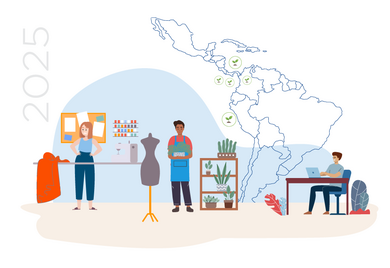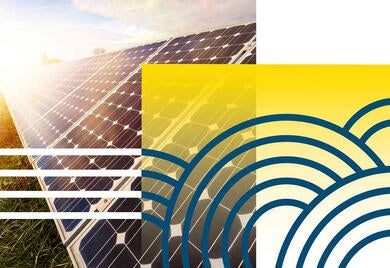
Let’s Not Lose This Window of Opportunity for Latin America and the Caribbean
The pandemic has devastated Latin America and the Caribbean, putting a strain on government finances, leaving the private sector in a leading position for the recovery. But we cannot forget the bigger picture: building a more inclusive and sustainable region.

Sustainability, the vaccine for Latin America and the Caribbean economies
A COVID-19 vaccine will keep people feeling healthy and safe, but we cannot forget to vaccinate our economies as well. Sustainability will be a key component to building back better in the region’s economic recovery.

How sustainable infrastructure can decide Peru’s future
Last March, Peru experienced extreme weather conditions in the north of the country. This resulted in numerous physical, economic and human losses with costs associated at over US$3 billion, or 0.5% of GDP. Planning for reconstruction, the country found itself at a crossroads: it could focus solely on meeting immediate construction needs or rebuild with a long-term vision. The latter option, to adapt the new infrastructure to the uncertainty of weather conditions, represents an opportunity to incorporate sustainability in highways, bridges, water distribution and management systems, as well as to leverage public-private partnerships and rebuild Peru’s economy to compete in the global market. The government of Pedro Pablo Kuczysnki has launched a reconstruction plan called “Reconstruction with Changes” which has two phases. The first seeks to invest up to US$3 million in immediate reconstruction and resettlement. The second, projected to last five years, focuses on the development of modern, climate-resilient public works that represent an additional investment of US$6 billion. A private sector opportunity A large part of infrastructure losses is absorbed by private markets, and for this reason the private sector has a lot to gain from reconstruction. For example, a new highway can allow products to reach their markets more quickly, lowering the cost of doing business for companies. The private sector not only benefits from reconstruction. It could also be part of its development. Estimates from the World Economic Forum suggest that for every dollar of public capital that is mobilized to close the infrastructure gap, five dollars of private capital should be mobilized. However, financing alone is not enough. Key tools for reconstruction IDB Invest (formerly known as Inter-American Investment Corporation), the IDB Group’s private sector arm, has experiences in technical assistance that can serve as a reference for Peru. In Mexico’s Port of Manzanillo, we found ways to adapt the design of the port to unpredictable weather conditions. This included ensuring reforestation and measuring the port’s carbon emissions. We made sure that the terminal operators have the tools and training necessary to replicate the environmental assessments every year. We also use the Envision methodology, developed by Harvard University’s Zofnass Program for Sustainable Infrastructure and the Sustainable Infrastructure Institute. The methodology focuses on quality of life, leadership, resource allocation, the natural world and climate, and risk. The tool has helped our clients measure sustainability, particularly during project planning and design phases. Environmental and social safeguards promote minimum quality in infrastructure investments. In June 2014, during the review of a loan to a local cement plant, our environmental models predicted atypical rains in Asunción, Paraguay. Our environmental specialists needed a contingency plan. When flooding occurred, the plant mitigated damage although there were some construction delays. The project’s sponsor recognized the importance of the environmental safeguard measures and invested in additional water studies, new internal routes with barriers and protected storage facilities. [clickToTweet tweet="For every dollar of public capital in #infrastructure, US$5 of private capital should be mobilized" quote="For every dollar of public capital that is mobilized in infrastructure, five dollars of private capital should be mobilized" theme="style1"] Corporate governance safeguards and attention to integrity also strengthen infrastructure sustainability. Although Latin America is a middle income region, two-thirds of its countries fall in the bottom half of Transparency International’s “corruption perception index.” According to this organization, 26% of Peru’s population has been the victim of corruption. IDB Invest maintains the highest standards of integrity, and we are confident that with our support for the RCC we will reduce this rate. Finally, investments in sustainable infrastructure can attract institutional investors. Investing in socially and environmentally responsible companies is increasingly considered a fiduciary responsibility and a means for increasing the value of company assets over the long term. We have witnessed the interest of such investors when we presented sustainable and bankable investments. The Reventazón hydroelectric dam in Costa Rica and the Campo Palomas and Colonia Arias wind farms in Uruguay have been pioneer projects in attracting financing from local institutional investors. In Peru, we seek to leverage local money and our capacity to advise public-private partnerships to attract more local stakeholders. This is a critical moment, but Peru is well positioned to convert its losses into opportunities. Investments in sustainable infrastructure are the only guarantee for building a more inclusive, less vulnerable, and more competitive future in the 21st century. Subscribe to receive more content like this! [mc4wp_form]

International Women’s Day: more than a day for women and men
Going beyond the day itself, International Women’s Day is an opportunity for all to commit to advancing gender equality and create real workplace inclusion. I challenge you to go one step further and make gender equality everyone’s business.

The way to build the future is to invest in it
The world is evolving at exponential speeds. Technology is contributing to a future marked by major social and economic improvements. This is especially true in Latin America and the Caribbean. Mobile subscribers in the region have increased 800% in the last five years. In 2017, financial technology (fintech) companies transacted more than US$90 billion in transactions in the region, an amount that surpasses Panama’s gross domestic product (GDP). And the region already leads the world in clean energy. Private sector innovation and competition have led to much of these technological advances, but development challenges remain. The region’s productivity lags its East Asian peers. Financing gaps, such as infrastructure, amount to billions of dollars or over 2% of the region’s GDP, while women-led businesses are still less likely to access financing than their male counterparts. The speeds, flexibility and power of technology have their limits. Our clients in the region’s private sector have ambitious goals, and it will take a range of solutions to achieve them. Designing for trust and client-focus For example, AirBnB, a hotel retailer, has grown from zero to 24 million annual guests in less than a decade. AirBnB does rely on technological platforms to unite lodging supply with demand, but it is the company’s ability to foster trust that gave it market leadership. This means fostering trust not only in the company to match people and process payments but also fostering trust among complete strangers who share their homes with one another. AirBnb, like Netflix, iTunes and so many others, remind us that technology alone is not the real disruptor. Designing for trust and the client experience is much bigger. Staying relevant while building a better future The digital disruption leaves no room for complacency. In addition to upending the hotel industry, it has taken over taxi and retail services highlighting that the quest to stay relevant is more difficult than ever. These changes, coupled with cash strapped governments and geopolitical shifts, put pressure on development banks to turn the billions on their balance sheets into trillions of development finance. To compete in today’s world and achieve our collective development goals, we must find ways to solve tomorrow’s challenges. A client experience defined by process agility, product flexibility and a sense of trust will allow development banks to stay relevant in changing times. Staying relevant includes more equity and quasi-equity, such as mezzanine and subordinated debt, to grow companies and allow them to create jobs. It includes engaging institutional investors through products like B-Bonds and demonstrating that their investments in emerging markets can perhaps outperform their developed market comfort zone. Staying relevant includes offering more local currency so that borrowers can repay in the currency they are generating cash flow. We also work in a world of liquidity where cash is no longer king. Providing advisory and knowledge to our clients will be what adds value and defines our development impact. These are some of the ways development banks can better tailor client experiences, reduce risks and allow clients to focus on stimulating development. Today, we are launching the most consequential makeover in our history. We are revamping our vision, strategy, products, sectors and culture under the new brand IDB Invest. This is about our commitment to take the best of what works. Our synergies with IDB coupled with product flexibility and process agility incorporate the best of the public and private sectors. Our transformation may be facilitated by technology, but it will be driven by a quest to put clients at the center and earn their trust and business in return. This will ensure the development impact for all our stakeholders. Subscribe to receive more content like this! [mc4wp_form]

How to attract more private capital to PPPs
As an engine of economic growth and poverty reduction, PPPs are on the rise in Latin America and the Caribbean (LAC). In the last decade, there were approximately 1,000 PPP infrastructure projects valued at $360 billion. Especially, in our current market of constrained fiscal budgets and deep social inequalities, PPPs have become more relevant than ever. Despite this historic uptick, many projects cannot mobilize sufficient private capital. PPPs crowd-in approximately one dollar of commercial finance for every dollar of public finance – a 1:1 ratio which has failed to close the infrastructure funding gap. On the supply side, institutional investors hold funds equivalent to 20 percent of the region’s GDP - a compelling figure when we seek an additional 2-2.5 percent of GDP to meet demand. Managing long-term assets like pensions and insurance is an ideal match for the long-term tenors of PPP projects. In addition, PPPs offer investors relatively predictable repayment schedules, promising financial returns and protection from inflation. In the past, private capital, namely from institutional investors, has been cautious. However the ability to mitigate certain risks is making projects more bankable and piquing investor interest. 1. Legal and regulatory risks Legal and regulatory risks span policies, regulations and institutions. Strengthening them to address market failures, incentivize risk-sharing and regulate consistently reassures investors. Countries are setting up government agencies and units with expertise to supervise PPPs. Advisory services to governments can further strengthen institutions, their regulators and supervisory mechanisms as well as long-term project programming. 2. Project preparation risk Capacity-building combined with the right incentives can mitigate project preparation risk. This can optimize project efficiency, predictability and investor-friendliness. Technical assistance can support project investment plans and share knowledge with public officials at PPP promotion agencies. Supporting investment planning can align PPP development with nationally- determined contributions. This fosters more climate-resilient, sustainable projects. Advisory also allows governments to determine optimal delivery models by conducting value for money assessments to ensure each asset brings value to government agencies, investors and end-users. 3. Foreign exchange risk Most PPPs, except for many in the energy sector, where they are often dollar-denominated, rely on local currency. For a PPP to succeed, avoiding foreign exchange risk is key. Governments are limited in the amount of dollars they can guarantee. Mobilizing local currency allows local borrowers to repay in the currency they are generating cash flow, avoiding mismatches. Currency risk can be mitigated by investors setting up local treasuries to issue debt in local currencies or by providing local currency guarantees project-by-project. 4. Construction risk Construction risk includes expropriation, geological and additional exposures to loss during the construction phase. Investors prefer to invest in PPPs only once construction is complete. However, de-risking projects through liquidity facilities, blended finance, subordinated debt and completion guarantees, which cover construction risk and up to the first 24 months of operation, can bring further comfort and incentivize early entry. Multilateral development banks are uniquely positioned to offer many of the solutions that address legal, regulatory and project preparation risks. IDB Invest (formerly known as Inter-American Investment Corporation), on behalf of the IDB Group, recently mitigated risks and attracted institutional investors in the Reventazón hydropower project in Costa Rica and Campo Palomas and Colonia Arias wind farms in Uruguay. The next phase seeks to bring institutional investors to PPPs and at construction phase. Besides, we can lend in local currency, as we are currently doing in Paraguay, Brazil, Colombia and Mexico, and we can also deploy guarantee and debt instruments to mitigate construction risk. Our in-house experts analyze infrastructure pipelines, support country planning and deploy financial and non-financial products that enhance infrastructure project risk profiles. IDB Invest, on behalf of the IDB Group, recently mitigated risks and attracted institutional investors in the Reventazón hydropower project in Costa Rica and Campo Palomas and Colonia Arias wind farms in Uruguay. The next phase seeks to bring institutional investors to PPPs and at construction phase. As the region’s PPP pipelines continue to grow, we will deploy the solutions to maximize PPP bankability and mobilize more financing. The boost we see in PPPs brings benefits for governments, private firms and the citizens of the countries we serve. [gallery type="slideshow" link="none" size="full" ids="7775,7776,7777"] Subscribe to receive more content like this! [mc4wp_form]